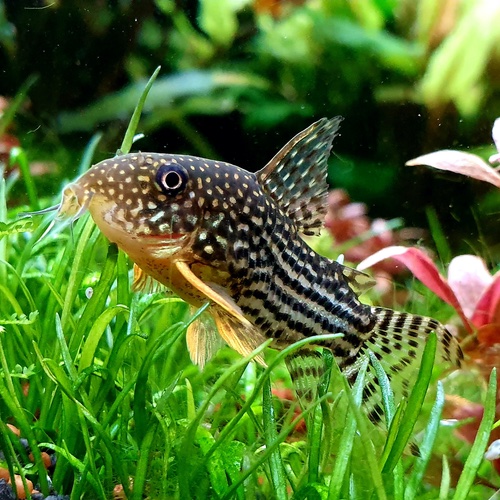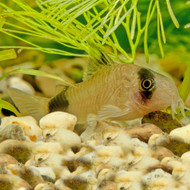Top 10 Best Fish for Planted Aquariums (Part II - Scavenging Fish).
Posted by Artur Wlazlo on 28 Dec 2022
In our first installment on the best fish for the planted aquarium, we talked about algae-eating fish. We chose three plecos in that category that are the best algae-eating fish and will help keep your aquarium plants free of algae. In this segment, we will talk about scavenging fish for your planted aquarium.
SCAVENGING FISH FOR PLANTED AQUARIUM
Many plants produce fine or grass-like leaves. For example, Hairgrass, Microswords, Pearlweed, or Babytears are foreground plants with the types of fine or small leaves that will trap debris. In rivers or lakes, the current will sweep that debris away and not allow it to settle on the plant’s leaves. Removing debris is critical in keeping these plants clean and in tip-top shape. Plants free of debris will absorb more light. The removal of debris will also prevent algae growth on their leaves. In aquariums, however, recreating this phenomenon may be more challenging. Strategically placed power heads, air stones, or filter outlets can direct water currents and help to unsettle trapped debris. Another great solution – and much more entertaining - are small scavenger fish.
4. Corydoras Catfish
Corydoras catfish are ideal scavenger fish for this task. There are many corydoras to choose from and all are excellent scavengers. By constantly scavenging for food among aquarium plants, they will stir up debris and help move it toward the main water column where it can eventually be pulled in by the aquarium filter and removed from the aquarium.

Sterbai Cory is a particularly beautiful fish with an unusual pattern. The top of the fish is speckled and the rest of the body transitions into several thin, irregular, and dark bands or lines. Sterbai Cory's anal, caudal and dorsal fins are also richly speckled. This cory's cheek area and the pectoral fin can be a rich golden yellow or brown and these warm hues may extend over most of its body.
Sterbai Cory is found in the upper Guapore River system in Bolivia and Brazil as well as in the Ucayali River system in Peru. Together with other cory catfish, they belong to the genius Callichthyidae and subfamily Corydoradinae.
Julii Cory is another great choice for a planted aquarium. This cory's body is lightly colored in hues of white/gray and ivory with a multitude of contrasting dark spots and a noticeable black stripe running the length of its body. The black speckles are also found on the fins.
Pygmy Cory is the smallest member of the corydoras catfish group. Aside from their small size, they are also distinguished by their pattern of horizontal black stripes/blotches on the rich golden yellow or brown body. Even more active than other corys, Pygmy Corys are ideal for nano or community tanks.

Cory catfish can be kept in a wide range of aquarium conditions and are ideal for mixed community aquariums because of their small size and friendly disposition. They will do great and exhibit the most interesting behavior in well-planted aquariums, with some hiding places provided by driftwood and rocks. Aquariums should also have some open areas where they can swim together in groups. Corys are very social and should be kept in groups of six, preferably more. They are very active fish and will constantly swim back and forth, providing never-ending entertainment.
Corys can be kept with many other peaceful fishes, including discus, tetras, dwarf cichlids, plecos, guppies, and many other community fish. They will readily accept a variety of foods, including flakes, pellets, freeze-dried and frozen foods.
5. Kuhli Loaches
Kuhli Loaches are great scavengers. They will bury themselves underneath the top layer of the substrate and move along, helping to turn over its top layer. By turning over the top layer of the substrate, Kuhli Loaches help remove debris and prevent algae growth. They can be elusive and difficult to spot. Still, their benefit to the planted aquarium is unquestionable.

Kuhli Loaches are great beginner fish. They are hardy and have a friendly disposition. They have a very unique snake-like body shape and coloration. They are very social fish and should be kept in small groups. They will scavenge and eat anything and everything that finds its way to the bottom of the aquarium.
While these scavengers do not eat algae, they are essential for planted aquariums. By scavenging for uneaten food, they dislodge and help clean out debris that settled on the bottom of the aquarium and among or on the leaves of aquarium plants. Removing trapped debris is as important – perhaps even more - as algae removal because it has the potential to stop the algae from appearing in the first place. In our next installment, we will talk about beautiful and noteworthy fish for a planted aquarium.

